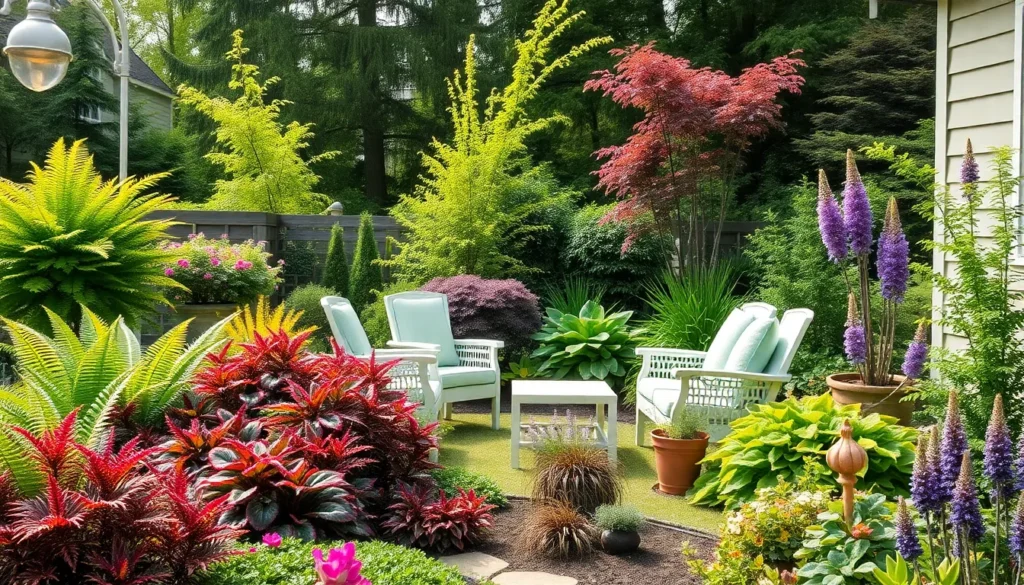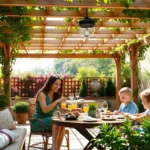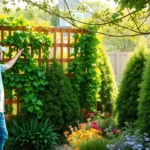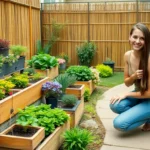North-facing gardens often get labeled as challenging spaces that limit your planting options. We understand why many gardeners feel discouraged when they realize their outdoor sanctuary receives limited direct sunlight throughout the day. But, we’re here to completely shift that perspective and show you how these unique spaces can become absolutely stunning.
Your north-facing garden isn’t a limitation – it’s an opportunity to create something truly special. We’ve discovered countless ways to transform these shaded retreats into lush, vibrant outdoor havens that rival any sun-drenched space. From selecting the perfect shade-loving plants to implementing clever design strategies, there’s so much potential waiting to be unlocked.
We’ll guide you through proven techniques that work specifically for north-facing gardens, helping you maximize every square foot of your space. Whether you’re dealing with deep shade or dappled light, we’ve got the insights you need to create your dream garden.
Understanding Your North Facing Garden’s Unique Conditions
Before we can transform our north facing garden into a thriving sanctuary, we need to thoroughly understand its exact environmental characteristics.
Assessing Light Levels Throughout the Day
Morning hours bring the most direct sunlight to north facing gardens, typically between 6 AM and 10 AM during summer months. We should observe our garden’s brightest spots during this window to identify prime planting locations for any sun loving specimens.
Filtered light dominates most north facing spaces throughout the day, creating ideal conditions for shade tolerant plants like hostas, ferns, and astilbe. This gentle illumination prevents leaf scorch while still providing enough energy for photosynthesis.
Seasonal variations dramatically affect our garden’s light exposure, with winter months receiving significantly less illumination than summer. We can expect 2 to 4 hours of direct sunlight during peak growing season, compared to potentially zero direct sun in winter months.
Light meters help us measure exact foot candle readings in different areas, allowing us to match plants with their optimal light requirements. Most shade loving plants thrive in 1,000 to 3,000 foot candles, which perfectly matches typical north facing garden conditions.
| Light Condition | Foot Candles | Best Plant Types | Peak Hours |
|---|---|---|---|
| Deep shade | 500-1,000 | Moss, some ferns | None |
| Partial shade | 1,000-3,000 | Hostas, heuchera | 6-10 AM |
| Dappled light | 2,000-4,000 | Astilbe, begonias | 6 AM-12 PM |
Evaluating Soil Moisture and Drainage
Higher moisture retention characterizes most north facing gardens due to reduced evaporation from limited sun exposure. We often find soil staying damp longer than south facing counterparts, which benefits moisture loving plants but requires careful drainage planning.
Drainage testing reveals whether our soil holds water appropriately or creates problematic soggy conditions. We can dig a 12 inch deep hole, fill it with water, and observe how quickly it drains to determine if amendments are necessary.
Organic matter improves both drainage and moisture retention, creating the balanced conditions most shade plants prefer. We should incorporate 2 to 3 inches of compost annually to maintain optimal soil structure and nutrient levels.
Waterlogged areas may develop in poorly draining north facing gardens, especially during rainy seasons. These spots require either drainage answers like French drains or plant selections that tolerate wet feet, such as cardinal flower or monkey flower.
Identifying Microclimates in Your Space
Existing structures create distinct growing zones within our north facing garden through varying shade depths and wind protection. We can map these areas to optimize plant placement based on each microclimate’s exact conditions.
Building proximity affects both temperature and moisture levels, with areas closer to structures typically staying warmer and drier. These spots often support plants that need slightly more warmth or better drainage than the garden’s general conditions allow.
Tree canopy variations create graduated shade levels from deep shade directly beneath mature trees to brighter conditions at canopy edges. We should identify these transition zones to create layered plantings that maximize visual interest and plant diversity.
Wind patterns influence both moisture levels and plant selection, with sheltered areas retaining more humidity while exposed sections may require hardier specimens. Observing seasonal wind changes helps us choose appropriate plants and position delicate varieties in protected locations.
Slope orientation within our north facing garden creates additional microclimates, with gentle slopes often providing better drainage while low lying areas collect moisture. These elevation changes allow us to accommodate plants with varying water requirements within the same garden space.
Selecting Shade-Tolerant Plants for Maximum Impact
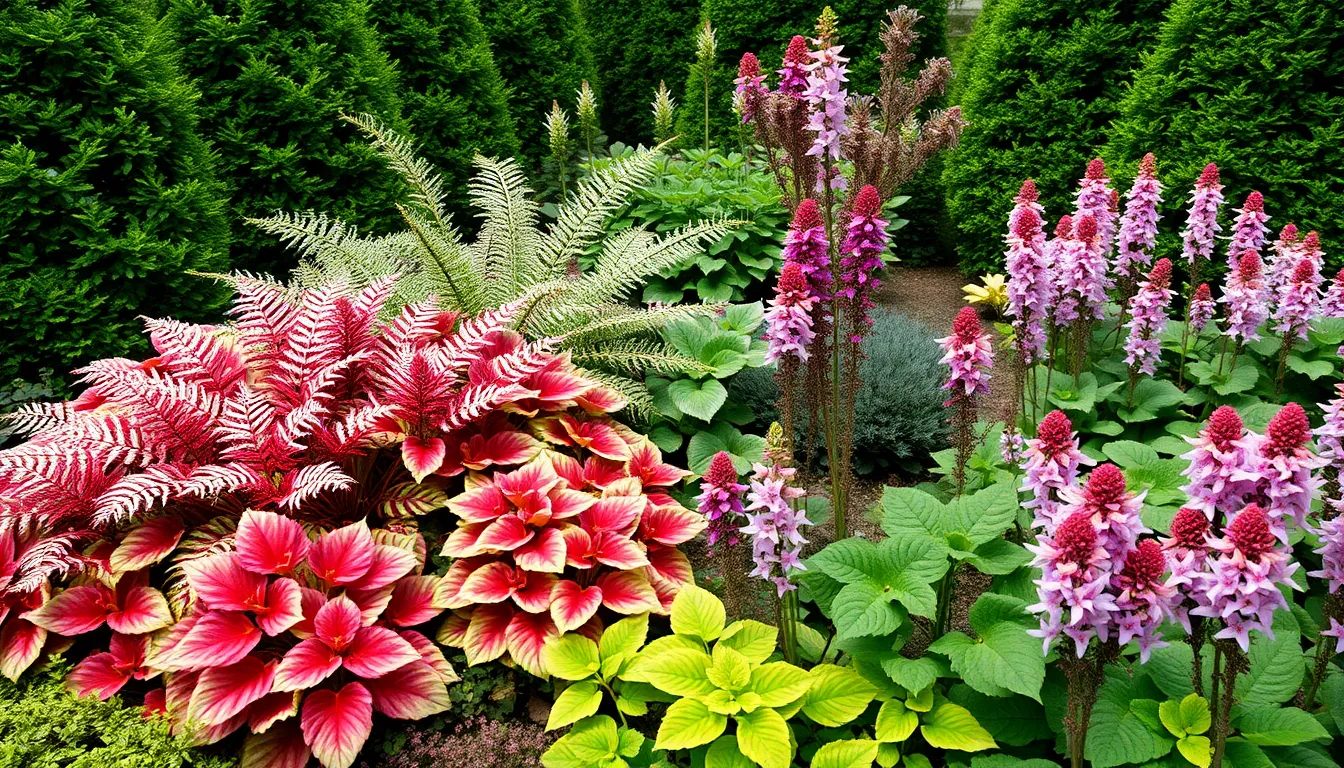
Success in north facing gardens starts with choosing plants that thrive in cool, moist environments rather than struggling against limited sunlight. We’ll focus on species that transform these challenging conditions into stunning garden displays.
Choosing Colorful Foliage Plants
Foliage plants with variegated or brightly colored leaves create instant visual drama in shady spaces where flowers might struggle. Japanese painted fern (Athyrium niponicum) delivers silvery fronds with purple stems that practically glow in filtered light. Coral bells (Heuchera) offer leaves in burgundy, lime green, and peachy orange that maintain their vibrant colors throughout the growing season.
Variegated Solomon’s seal (Polygonatum odoratum ‘Variegatum’) brings elegant arching stems with cream edged leaves that brighten dark corners effectively. These plants help create a ever-changing garden palette that doesn’t rely on abundant blooms for impact. Color variations in foliage ensure year round interest when flowers fade or aren’t present.
Incorporating Flowering Shade Perennials
Reliable flowering perennials add seasonal color bursts to shade dominated areas without requiring full sun exposure. Astilbes produce feathery plumes in pink, white, or red that create soft texture contrasts against broader leafed companions. Bleeding hearts (Dicentra) contribute heart shaped flowers in spring that dangle gracefully from arching stems.
Lungwort (Pulmonaria) provides early spring blooms in blue, pink, or white while offering spotted foliage that extends visual interest through summer months. These perennials ensure color and structure throughout the growing season in areas where sun loving plants would fail. Timing their bloom periods creates succession planting that maintains garden appeal from spring through fall.
Adding Evergreen Structure Plants
Evergreen foundation plants maintain garden form during winter months when deciduous companions retreat underground or lose their leaves. Boxwood (Buxus) creates neat hedging and topiary opportunities while tolerating shade conditions better than most evergreens. Yew (Taxus) offers dense, dark green foliage that provides excellent backdrop for lighter colored plantings.
Certain hollies (Ilex) contribute glossy leaves and colorful berries that attract birds while maintaining structure year round. These plants serve as the garden’s backbone, ensuring visual weight and privacy screening regardless of season. Combining evergreens with seasonal perennials and foliage plants creates balanced, layered effects that work in shade conditions.
Creating Depth and Interest with Layered Planting
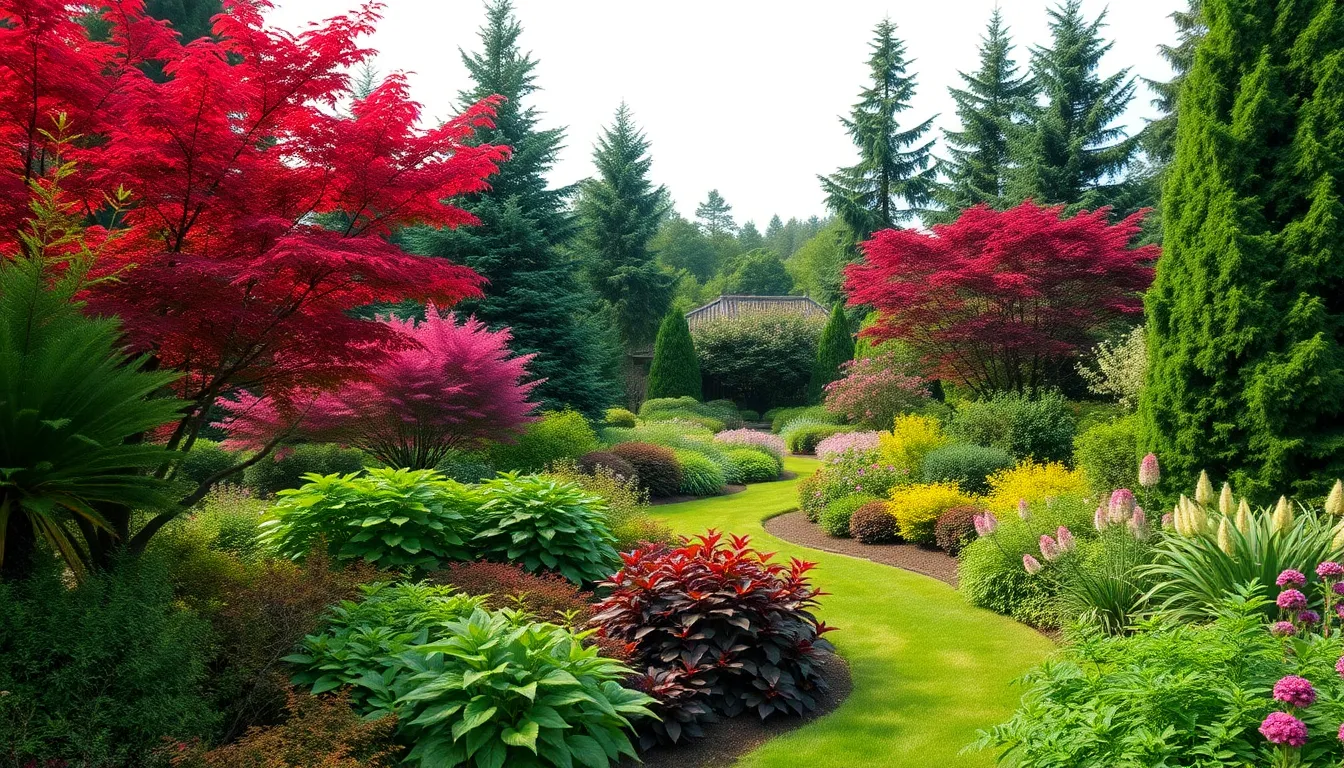
Layered planting transforms north-facing gardens into visually compelling spaces by combining plants with varying heights, textures, and foliage colors. We’ll explore how strategic layering creates the illusion of depth while maximizing the unique growing conditions that shade provides.
Establishing a Tree Canopy Layer
Trees form the backbone of our layered north-facing garden design by providing structure and establishing the upper canopy. Evergreen species like pine, spruce, and fir maintain consistent visual appeal throughout all seasons while creating natural windbreaks for lower plantings.
Deciduous options such as Japanese maple and serviceberry offer seasonal interest through spring flowers, summer foliage, and autumn color displays. We recommend positioning larger trees toward the garden’s perimeter to avoid blocking precious morning sunlight from reaching understory plants. Small ornamental trees like dogwood and redbud work exceptionally well as focal points in north-facing spaces since they naturally thrive in partial shade conditions.
Consider mature size when selecting canopy trees, as overcrowding reduces air circulation and creates deeper shade that limits plant choices below. Strategic placement allows morning light to filter through branches while providing afternoon protection for sensitive shade plants.
Building the Shrub and Understory Level
Shrubs create the middle layer that bridges our tree canopy with ground level plantings. Heuchera and coral bells excel in north-facing conditions, offering colorful foliage in burgundy, chartreuse, and silver tones that brighten shaded areas year-round.
Hellebores provide early spring blooms when few other plants flower, making them invaluable for extending seasonal interest. These hardy perennials tolerate deep shade and establish robust clumps that return stronger each year. Climbing vines like star jasmine maximize vertical space by growing toward available sunlight while adding fragrant blooms to walls and trellises.
Rhododendrons and azaleas create stunning spring displays with their abundant flowers in pink, white, and purple shades. Native shrubs such as spicebush and elderberry support local wildlife while providing berries and seasonal color changes. We group shrubs in odd numbers and vary their heights to create natural looking compositions that mimic woodland settings.
Designing Ground Cover Combinations
Ground covers complete our layered design by filling gaps between larger plants and providing uniform base coverage. Impatiens deliver continuous color throughout the growing season in north-facing beds where other annuals struggle to bloom consistently.
Wintergreen offers year-round interest with glossy evergreen leaves and bright red berries that persist through winter months. This native ground cover spreads naturally to form dense mats that suppress weeds while requiring minimal maintenance. Ferns like Christmas fern and lady fern add delicate texture contrasts to broad-leafed companions.
Hostas anchor ground level plantings with their bold foliage in blue, green, and variegated patterns that complement other shade lovers. We combine different hosta varieties to create textural interest through leaf size and color variations. Pachysandra and wild ginger work as living mulch between specimen plants, reducing maintenance while creating cohesive visual flow throughout the garden space.
Maximizing Color in Low Light Conditions
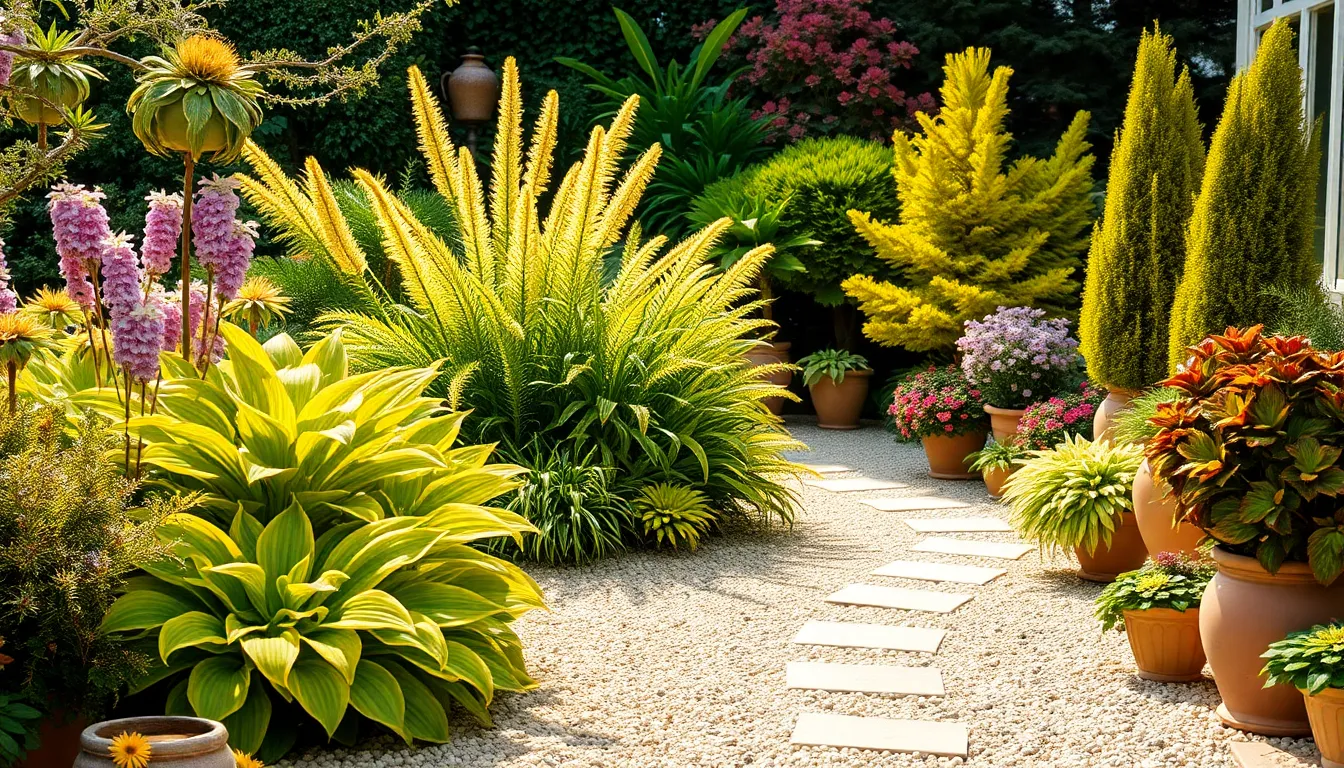
Creating vibrant visual interest in north-facing gardens requires strategic use of color elements that work effectively in shade. We can achieve stunning results by combining plants with varying foliage colors and strategic placement of bright accessories.
Utilizing Variegated and Golden Foliage
Variegated leaves add contrast and brightness to low-light areas where traditional flowering plants might struggle. Plants with cream, white, or yellow markings on their leaves create natural highlights that make shadowy spaces appear more luminous. Golden conifers like ‘Rheingold’ arborvitae or ‘Golden Spreader’ juniper provide year-round warm tones that glow even in filtered light.
Hostas with white or yellow variegation, such as ‘Patriot’ or ‘Sum and Substance’, create dramatic focal points in shade gardens. These plants reflect available light while maintaining their vibrant patterns throughout the growing season. Coral bells with golden or lime-colored foliage, including varieties like ‘Citronelle’ and ‘Key Lime Pie’, offer additional texture and color depth.
Golden-leaved shrubs serve as excellent backdrop plants that brighten entire garden sections. Spirea ‘Goldflame’ and golden elderberry create substantial color blocks that anchor planting schemes. We recommend positioning these plants where they’ll receive morning light to enhance their golden tones while protecting them from harsh afternoon sun.
Incorporating White and Pale Flowering Plants
White and pale-colored flowers reflect what little light is available, brightening spaces that might otherwise appear dim. These blooms create striking contrasts against darker foliage and seem to glow in twilight hours. White hydrangeas, particularly ‘Annabelle’ and ‘Incrediball’ varieties, produce large flower clusters that illuminate shaded corners from summer through fall.
Pale-colored begonias offer continuous blooms in containers and borders throughout the growing season. White caladiums provide dramatic heart-shaped leaves with green veining that creates sophisticated patterns in shade gardens. Astilbe varieties in cream and pale pink tones add feathery texture while maintaining subtle color that won’t compete with other garden elements.
White flowering bulbs extend the blooming season into early spring when north-facing gardens need the most help. Snowdrops, white crocuses, and pale daffodils create early season interest before deciduous trees leaf out. We suggest planting these bulbs in drifts to create maximum visual impact during the darkest months of the year.
Adding Bright Containers and Garden Accessories
Light-colored pathways and patios reflect available light and brighten entire garden spaces beyond individual plantings. Cream-colored gravel, pale stone pavers, or whitewashed concrete create surfaces that bounce light throughout the garden. These hardscape elements provide structure while contributing to the overall brightness of north-facing spaces.
Movable pots allow us to capture seasonal light changes by repositioning plants as needed throughout the year. Bright white, cream, or pale blue containers create striking contrasts against dark soil and green foliage. Large ceramic pots in light colors serve as sculptural elements that remain visually interesting even when plants aren’t in peak bloom.
Vertical gardening adds interest with wall-mounted planters or trellises that maximize growing space while creating layered displays. White or light-colored garden structures reflect light while supporting climbing plants and creating architectural interest. Garden accessories like bright ornaments, pale-colored garden seats, or reflective gazing balls enhance visual appeal by adding unexpected color and light-catching surfaces throughout shaded areas.
Designing Functional Zones for North Facing Spaces
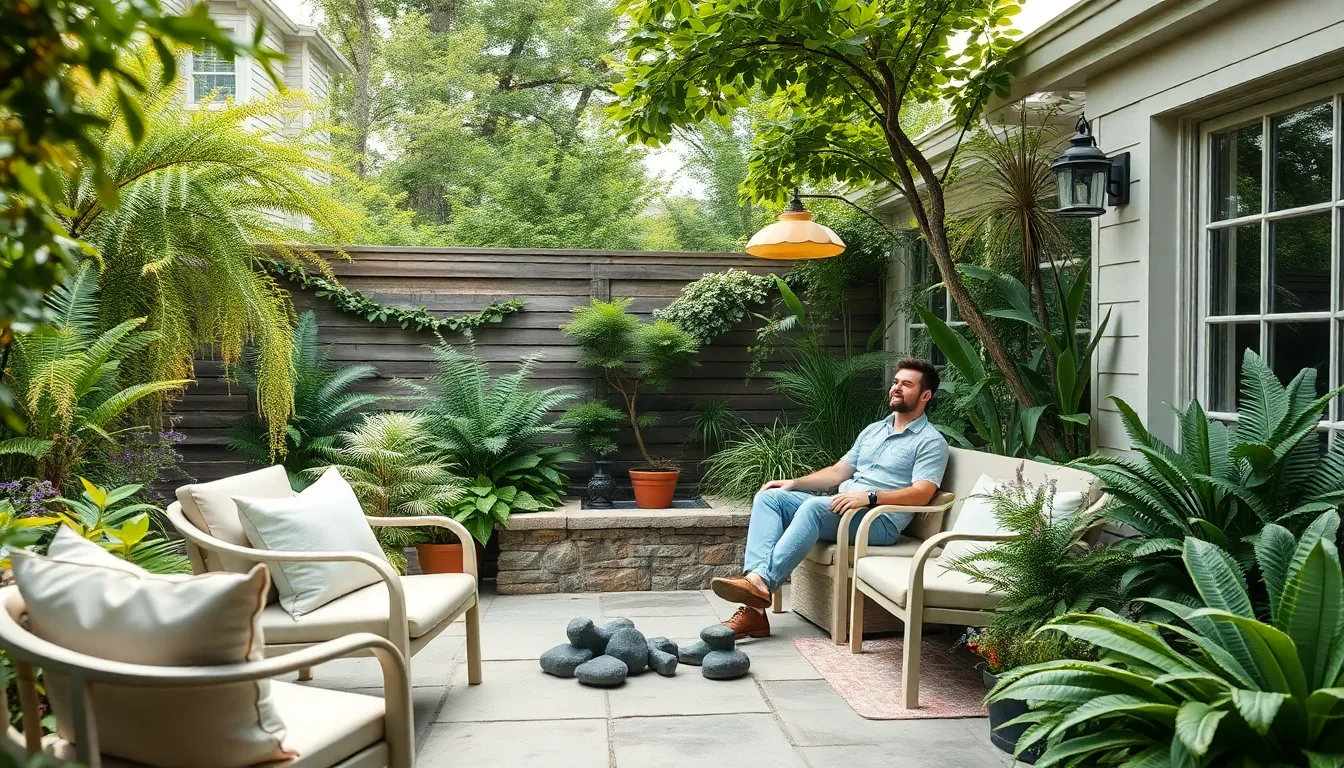
Successful north facing gardens require strategic planning to define distinct areas for different activities and maximize the limited sunlight available. We’ll show you how to create purposeful zones that transform your shaded space into a functional outdoor haven.
Creating a Cozy Seating Area
Position your outdoor furniture in spots that receive the most natural light throughout the day. The far end of your garden often captures afternoon sun, making it ideal for dining sets or lounge chairs. Light colored materials for paths and patio flooring help reflect available sunlight and brighten the entire seating zone.
Extend your space’s usability into evening hours with strategic outdoor lighting options. LED spotlights illuminate exact areas while solar lights create ambient pathways without requiring electrical connections. Fire pits serve dual purposes by providing both warmth and a cozy gathering point during cooler months.
Choose furniture materials that complement the cooler, shadier environment. Weather resistant options like teak or powder coated aluminum maintain their appearance in higher moisture conditions typical of north facing spaces. Add colorful cushions and throws to inject warmth and personality into your seating arrangement.
Establishing a Productive Herb and Vegetable Corner
Select shade tolerant vegetables that thrive in cooler conditions with less direct sunlight. Lettuce, kale, arugula, peas, beetroot, and baby carrots all flourish in partial shade environments. These crops often produce more tender leaves and less bitter flavors when grown away from intense sun exposure.
Incorporate herbs that naturally prefer shadier growing conditions for your culinary garden. Chives, parsley, coriander, oregano, and mint all perform well in north facing locations. Many of these herbs actually benefit from protection against harsh afternoon sun, which can cause them to bolt or develop bitter flavors.
Use vertical gardening techniques to maximize your growing space and help plants reach available light sources. Trellises support climbing vegetables like peas and beans while wall mounted planters create multiple growing levels. Movable pots offer flexibility to shift plants to sunnier spots as seasonal light patterns change throughout the year.
Designing a Tranquil Meditation Space
Create a peaceful retreat in the shadiest corners of your north facing garden using plants that thrive in low light conditions. Ferns, hostas, foxgloves, and evergreen shrubs form the foundation of a serene meditation area. Hellebores and coral bells add subtle color without requiring bright sunlight to flourish.
Incorporate natural materials and soft textures to foster a calming atmosphere in your quiet zone. Stone benches, wooden decking, or natural fiber cushions create comfortable seating for reflection. Water features like small fountains or bird baths introduce soothing sounds while wind chimes add gentle movement and melody.
Separate your meditation space from more active garden areas using low hedging or decorative screens. Bamboo panels or lattice work with climbing plants create natural privacy barriers. This physical separation enhances the sense of tranquility and allows you to fully disconnect from daily activities while enjoying your garden sanctuary.
Enhancing Your Garden with Water Features
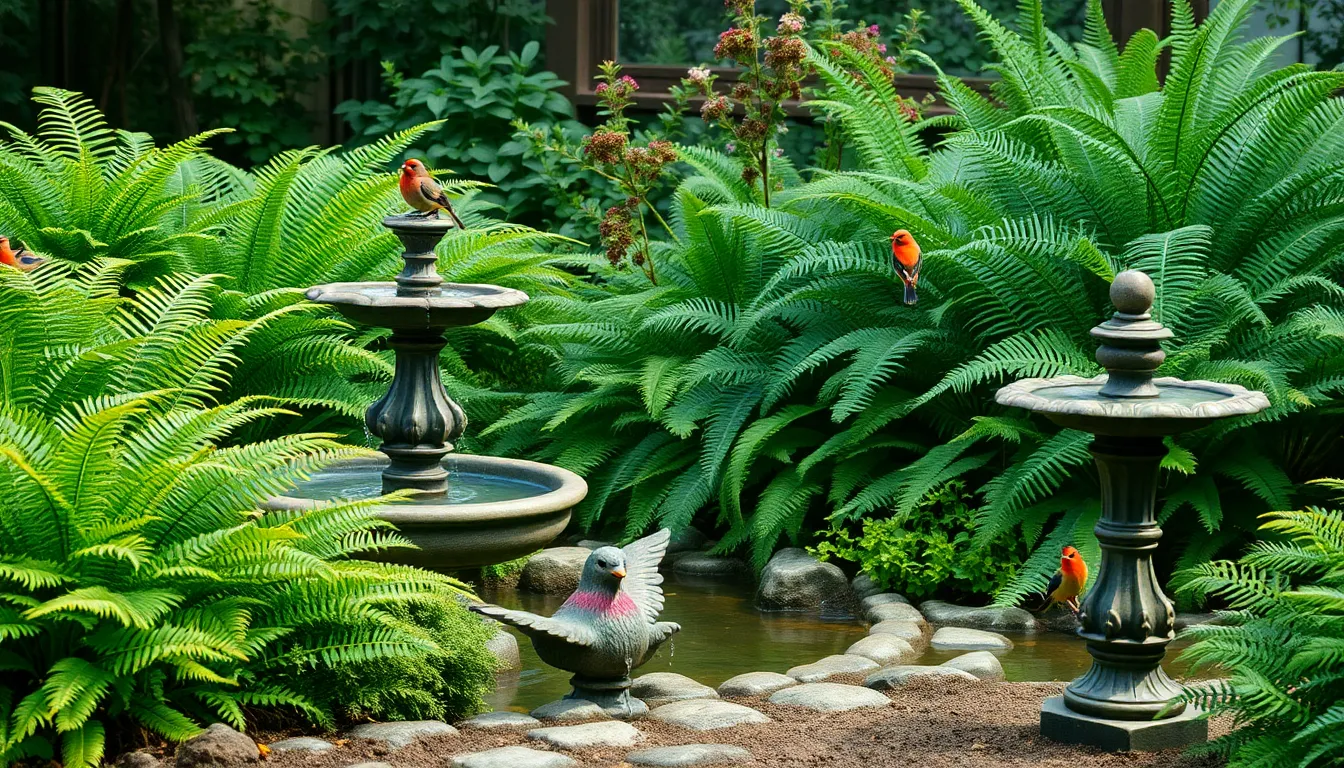
Water features transform north-facing gardens by adding sensory elements that compensate for limited sunlight. These elements introduce sound, movement, and visual interest while attracting wildlife to create a more ever-changing outdoor space.
Installing a Small Fountain or Birdbath
Small fountains create focal points that don’t require extensive space or direct sunlight to make an impact. We recommend positioning these features strategically in areas that catch some filtered light or serve as centerpieces among your shade-tolerant plantings. The gentle sound of flowing water establishes a calming atmosphere that masks urban noise while creating a peaceful retreat.
Birdbaths offer similar benefits while specifically attracting wildlife to your north-facing garden. Position them near windows or seating areas where you can observe visiting birds throughout the day. These compact water features work exceptionally well because they don’t depend on sunlight for their visual appeal and actually benefit from the cooler conditions that north-facing gardens provide.
Strategic placement near moisture-loving plants like ferns or hostas creates natural-looking vignettes. The sound and movement of water enriches your garden’s sensory experience while providing essential resources for local wildlife.
Creating a Shallow Pond or Water Garden
Shallow ponds serve as stunning centerpieces that reflect available light back into darker garden areas. We suggest incorporating shade-thriving aquatic plants like water lilies around the pond edges to create seamless integration with your existing industry design. Natural materials such as stone or wood help blend the water feature into your garden’s established character.
Water gardens in north-facing spaces benefit from the cooler temperatures and consistent moisture levels these locations naturally provide. Select plants that thrive in partial to full shade conditions, including moisture-loving ferns and sedges around the perimeter. The still water surface acts as a natural light reflector, helping brighten surrounding areas while adding visual depth to your garden layout.
Maintenance becomes easier in north-facing locations since reduced direct sunlight means less algae growth and slower water evaporation. This makes shallow ponds particularly suitable for gardeners seeking low-maintenance water features that provide maximum visual impact.
Adding Gentle Water Movement for Ambiance
Bubbling rocks introduce soft water sounds without requiring large water bodies or complex installation processes. We recommend these features for their ability to create tranquility while discouraging mosquito breeding through continuous water movement. Small waterfalls or trickling streams offer similar benefits while adding vertical interest to your garden design.
Water movement features work particularly well in north-facing gardens because they don’t rely on sunlight for their appeal. Instead, they enhance the garden’s acoustic environment and create focal points that draw attention away from any perceived limitations of reduced light. The sound of moving water transforms your outdoor space into a peaceful sanctuary.
These gentle water elements complement the cooler, more subdued atmosphere that north-facing gardens naturally possess. Trickling streams can be incorporated along pathways or near seating areas to maximize their sensory impact while requiring minimal maintenance compared to larger water features.
Incorporating Hardscaping Elements
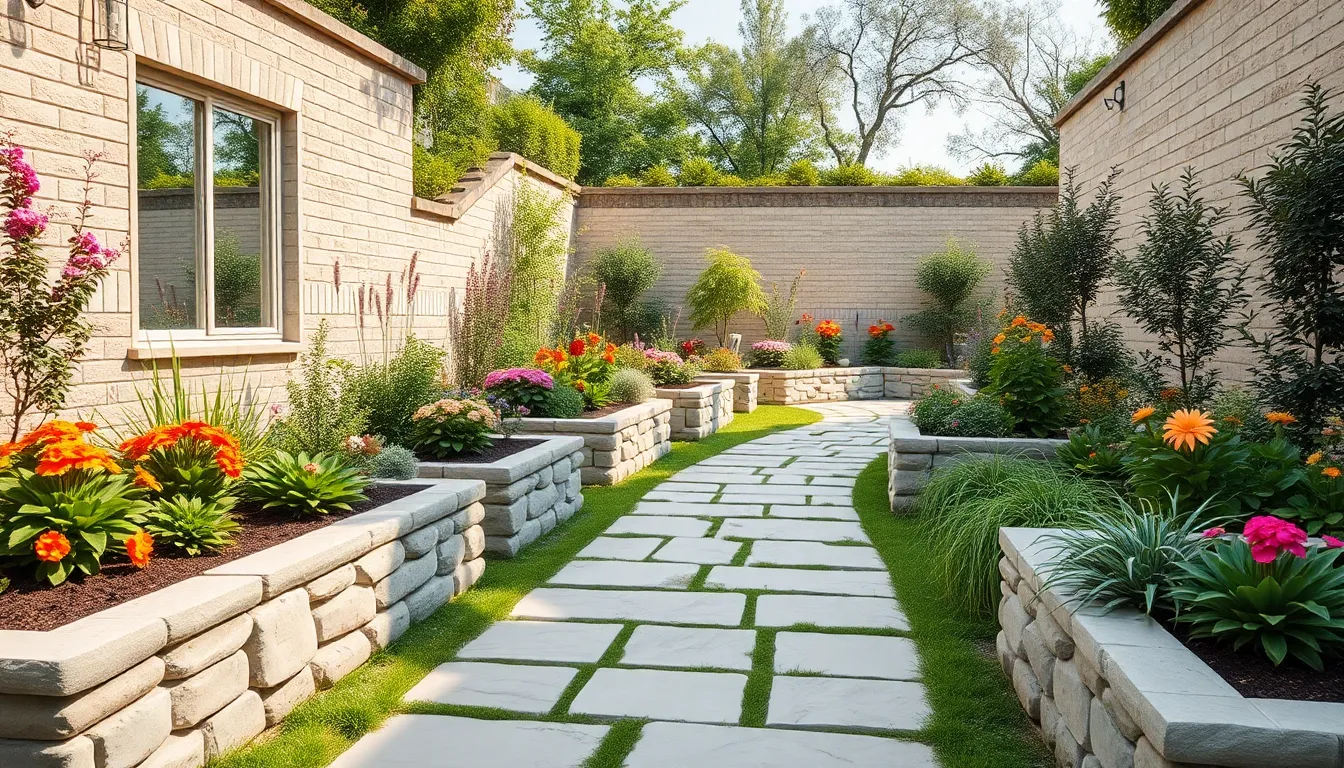
Hardscaping elements provide structure and functionality to north-facing gardens while reducing dependency on sun-loving plants. These permanent features create usable zones and define different areas of our garden, offering flexibility regardless of light levels.
Building Pathways with Light-Colored Materials
Light-colored materials like pale stone, limestone, or light-colored gravel help reflect sunlight rather than absorb it in our north-facing gardens. We can brighten the entire space by using these reflective surfaces for pathways and patios, creating an illusion of more space and enhanced illumination. Pale stone pathways particularly excel at bouncing available light back into surrounding planted areas.
Limestone pavers offer excellent durability while maintaining their light-reflecting properties throughout different weather conditions. We should consider light-colored gravel for budget-friendly pathway options that still provide the same brightening effect. These materials work especially well when we combine them with strategic placement near seating areas or focal points.
Adding Mirrors to Reflect Available Light
Mirrors strategically placed throughout our north-facing garden can amplify natural light and create visual depth in darker corners. We can position garden mirrors to catch morning sunlight and redirect it into shadowed areas where plants struggle to thrive. Weather-resistant outdoor mirrors offer both decorative and practical benefits for our shaded spaces.
Placing mirrors opposite light sources maximizes their effectiveness at bouncing available illumination throughout the garden. We should mount them on walls, fences, or integrate them into garden structures to enhance the ambiance naturally. Angled positioning helps direct reflected light into exact planting beds or seating areas where we need additional brightness.
Creating Raised Beds for Better Drainage
Raised beds improve drainage conditions that are critical in north-facing gardens, which tend to retain more moisture due to limited evaporation. We can create targeted growing environments by building raised structures that allow excess water to drain away from plant roots. These elevated planting areas also help us zone different sections of our garden effectively.
Better soil amendments become possible when we construct raised beds, allowing us to customize growing conditions for shade-tolerant plants and vegetables. We can fill raised structures with well-draining soil mixes that prevent waterlogging common in north-facing locations. The improved drainage conditions make it easier to grow a wider variety of plants, including some vegetables that typically struggle in consistently moist soil.
Maintaining Your North Facing Garden Throughout the Seasons
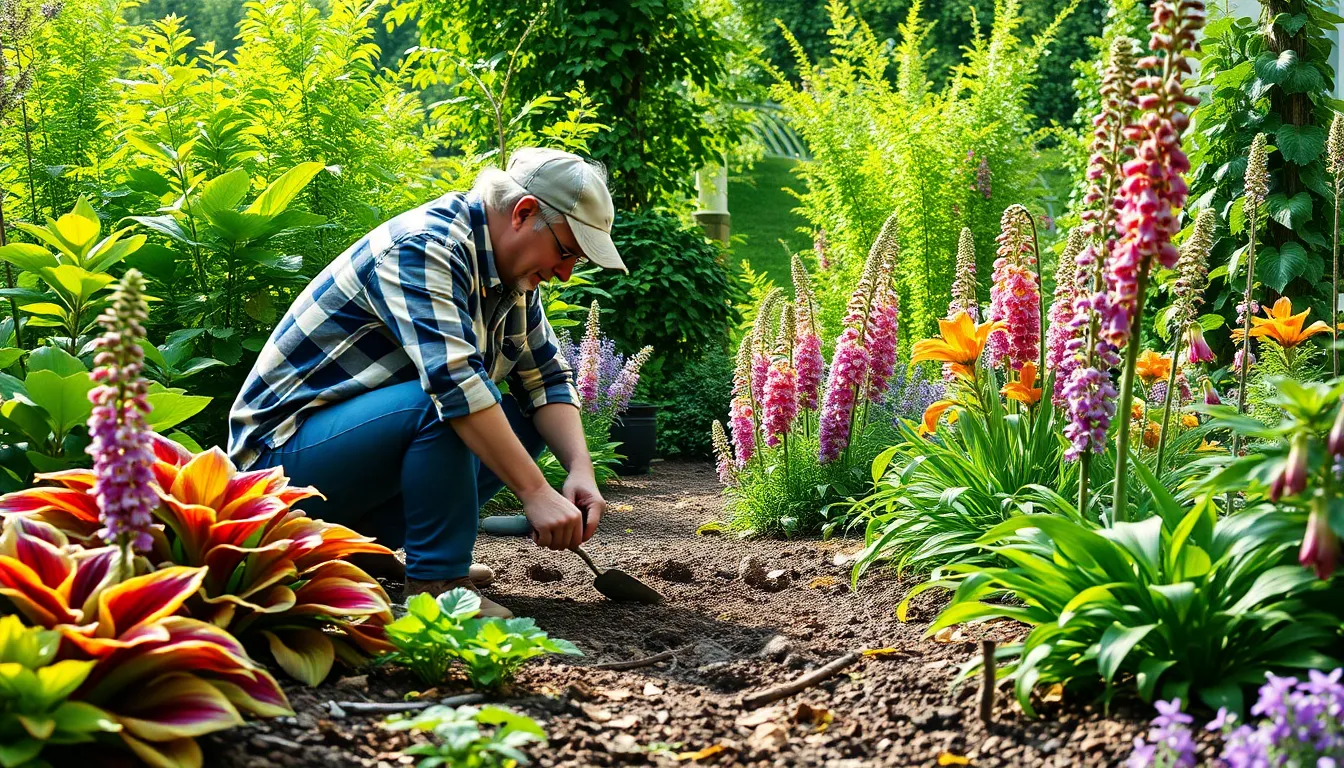
Seasonal maintenance ensures our north facing gardens remain healthy and vibrant year round. We’ll adapt our care routines to work with the unique conditions these spaces provide.
Spring Preparation and Planting Tasks
Soil preparation starts our gardening year with organic matter additions that improve structure and drainage. We incorporate compost or aged manure into existing beds to enhance moisture retention without creating waterlogged conditions.
Plant selection focuses on shade tolerant varieties that thrive in cooler temperatures and filtered light. Hostas, foxgloves, and irises establish well during spring months when soil temperatures begin warming.
Spring bulbs like snowdrops, crocuses, and daffodils should be planted in fall for early season color displays. These hardy varieties naturalize easily in north facing conditions and provide cheerful blooms before deciduous trees leaf out.
Mulching around established plants helps regulate soil temperature and moisture levels. We apply a 2 to 3 inch layer of organic mulch while keeping material away from plant stems to prevent pest and disease issues.
Summer Watering and Care Routines
Deep watering promotes healthy root development by encouraging plants to grow deeper rather than spreading horizontally near the surface. We water thoroughly but less frequently to avoid creating consistently soggy conditions that can lead to root rot.
Morning irrigation takes advantage of the period when north facing gardens receive their most direct sunlight. This timing allows plants to absorb moisture before temperatures drop and helps prevent fungal diseases that thrive in cool, damp conditions.
Moisture monitoring becomes essential during dry spells since shade loving plants still require consistent hydration. We check soil moisture levels regularly by inserting our finger 2 inches deep into the earth around plant bases.
Pruning and deadheading keeps our gardens looking tidy while encouraging continued growth and flowering. Summer maintenance includes removing spent blooms from shade perennials and trimming back any damaged or diseased foliage.
Fall Cleanup and Winter Protection
Leaf removal prevents matting that can smother grass and low growing plants throughout winter months. We rake fallen leaves regularly rather than allowing thick layers to accumulate on garden beds and lawn areas.
Protective measures shield tender plants from harsh winter conditions using burlap wraps or temporary covers. Evergreen shrubs like wintergreen and coast leucothoe benefit from wind protection during their first few years of establishment.
Autumn plantings of cyclamen, winter aconites, and heathers provide off season color when most other plants have finished blooming. These hardy varieties establish well in fall and offer visual interest during the dormant season.
Tool maintenance prepares our equipment for storage while ensuring everything functions properly when spring arrives. We clean, oil, and sharpen garden tools before storing them in dry locations away from moisture and temperature fluctuations.
Conclusion
North-facing gardens offer incredible potential when we embrace their unique characteristics rather than fighting against them. With the right combination of shade-loving plants layered planting techniques and strategic design choices we can create stunning outdoor spaces that rival any sun-drenched garden.
The key lies in working with nature’s rhythm – understanding how light moves through our space throughout the day and seasons. By selecting appropriate plants creating distinct functional areas and maintaining consistent seasonal care we transform what many consider a gardening challenge into a peaceful productive sanctuary.
Remember that every garden tells its own story. Our north-facing spaces may receive less direct sunlight but they reward us with cooler temperatures longer-lasting blooms and the opportunity to cultivate plants that simply can’t thrive elsewhere. Start with one area and gradually expand your vision – you’ll be amazed at what’s possible.
Frequently Asked Questions
What makes north-facing gardens challenging for gardeners?
North-facing gardens receive limited direct sunlight, with most illumination being filtered throughout the day. They typically get the most direct sun during morning hours, while winter months see significantly reduced light levels. These conditions require specific plant selections and design strategies to create thriving outdoor spaces.
Which plants work best in north-facing gardens?
Shade-tolerant plants thrive in north-facing gardens. Excellent choices include colorful foliage plants like Japanese painted ferns and coral bells, flowering perennials such as astilbes and bleeding hearts, and evergreen plants like boxwood and yew. These species create visual interest while adapting well to cooler, shadier conditions.
How can I add color to my north-facing garden?
Maximize color by incorporating variegated and golden foliage plants like hostas and golden conifers. Use white and pale flowering plants to reflect available light and create contrast. Add bright containers, light-colored pathways, and decorative elements to enhance brightness and visual appeal in low-light conditions.
What is layered planting and why is it important?
Layered planting creates depth by organizing plants into three tiers: trees forming the upper canopy, shrubs as the middle layer, and ground covers at the base. This approach maximizes space utilization, allows morning light to filter through effectively, and creates visual interest while ensuring each plant receives appropriate growing conditions.
How should I maintain my north-facing garden seasonally?
Spring maintenance includes soil enhancement and mulching for moisture regulation. Summer care focuses on deep watering and monitoring moisture levels. Fall tasks involve leaf removal and protecting tender plants, while selecting hardy varieties for off-season color. Regular tool maintenance ensures garden readiness year-round.
Can I grow vegetables and herbs in a north-facing garden?
Yes, many shade-tolerant crops and herbs thrive in cooler conditions. Focus on leafy greens, herbs like parsley and chives, and vegetables that don’t require full sun. Vertical gardening techniques help maximize growing space, while proper soil preparation ensures healthy plant development in limited light conditions.
How do I create functional spaces in my north-facing garden?
Define distinct areas for different activities by creating cozy seating spots that capture maximum sunlight using light-colored materials. Establish productive growing corners with shade-tolerant plants, and design tranquil meditation spaces using natural materials and low-light plants to foster a calming atmosphere throughout your garden.

